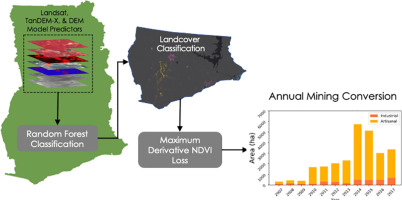
Effects of Galamsey in Ghana: Environmental and Societal Impacts
Meta Description: Explore the harmful effects of galamsey, illegal mining in Ghana, including environmental destruction, pollution, and socio-economic challenges. Learn about the long-term consequences.
Highlights:
- Effects of Galamsey: Environmental and Societal Impacts in Ghana
- Environmental Effects of Galamsey
- Societal and Economic Impacts of Galamsey
Effects of Galamsey: Environmental and Societal Impacts
in Ghana
Introduction
Galamsey, the term for illegal small-scale mining in Ghana,
has emerged as a pressing issue with widespread implications. Although it
provides income to miners and gold to the market, the effects of galamsey on
both the environment and society are overwhelmingly negative. This expository
essay delves into the major effects of galamsey, analyzing the environmental
degradation, societal harm, and long-term consequences for Ghana’s economy and
public health.
Environmental Effects of Galamsey
The environmental impact of galamsey is profound and one of
its most destructive consequences. Illegal mining operations, often
unregulated, have led to significant degradation of Ghana’s natural resources.
The following are the most notable environmental effects:
- Water
Pollution: Galamsey activities frequently occur near rivers and water
bodies. To extract gold, miners often use harmful chemicals, such as
mercury and cyanide, which are dumped into these water sources. The
contamination of rivers like the Pra and Ankobra, which are critical
sources of drinking water and irrigation for agricultural lands, has led
to water shortages and public health crises in several regions.
- Deforestation
and Land Degradation: Illegal miners clear vast tracts of forested
land to make way for their operations. This deforestation not only leads
to a loss of biodiversity but also increases the risk of soil erosion. The
removal of trees and vegetation weakens the land, making it prone to
landslides and reducing agricultural productivity in affected areas.
- Soil
Erosion: Due to the lack of land reclamation practices, galamsey
causes soil erosion, which strips the topsoil needed for farming. As a
result, areas once known for agricultural productivity are left barren,
reducing food security for local communities and exacerbating poverty.
- Destruction
of Ecosystems: The loss of vegetation and water pollution harms local
ecosystems. Wildlife is displaced, and aquatic life in rivers contaminated
by mining chemicals cannot thrive, creating imbalances that ripple through
the entire ecosystem.
Societal and Economic Impacts of Galamsey
The social and economic effects of galamsey are equally
troubling, contributing to broader socio-economic challenges in Ghana.
- Health
Risks: The use of toxic chemicals such as mercury in gold extraction
poses severe health risks to miners and nearby communities. Long-term
exposure to mercury can cause neurological damage, respiratory issues, and
kidney problems. Polluted water sources further compound public health
risks, as communities reliant on rivers for drinking and farming are
exposed to chemical contaminants.
- Displacement
and Conflict: The expansion of illegal mining often leads to conflicts
between miners and local communities. Landowners and farmers are
frequently displaced from their lands without compensation, as galamsey
operations spread into agricultural zones. Tensions arise as communities
compete for dwindling resources like clean water, leading to social
unrest.
- Economic
Disruption: While galamsey may offer immediate financial gain to
individuals, it undermines the broader economy. Illegal mining circumvents
the regulatory systems in place, depriving the government of taxes and
royalties that could be invested in infrastructure, healthcare, and
education. The destruction of farmland further reduces agricultural
output, weakening rural economies.
- Child
Labor and Exploitation: Galamsey often involves children, exposing
them to hazardous working conditions, toxic chemicals, and long hours.
This exploitation not only denies children access to education but also
perpetuates the cycle of poverty in regions where illegal mining thrives.
Long-Term Consequences and Government Response
The long-term consequences of galamsey are alarming.
Persistent environmental degradation, particularly water contamination and
deforestation, has lasting effects on food security and public health.
Moreover, the depletion of natural resources limits future economic
opportunities, as land and water become increasingly unusable.
In response, the Ghanaian government has implemented several
measures to curb illegal mining. These include the introduction of task forces,
a temporary ban on small-scale mining, and stricter licensing requirements for
legal mining activities. Additionally, there are efforts to rehabilitate lands
damaged by galamsey through reforestation projects and water body cleanups.
Despite these efforts, challenges remain, as poverty,
unemployment, and high demand for gold continue to drive illegal mining
activities. A comprehensive, multi-stakeholder approach, including community
engagement and enforcement of sustainable mining practices, is essential to
mitigating the effects of galamsey in the long term.
Conclusion
The effects of galamsey in Ghana are multifaceted and devastating, impacting both the environment and society at large. While it may provide short-term benefits to individuals, the long-term consequences—water pollution, deforestation, health risks, and economic disruption—are too significant to ignore. Addressing galamsey requires a balance between regulation, sustainable mining practices, and support for alternative livelihoods, ensuring that Ghana’s natural resources are preserved for future generations.
- Keywords: effects of galamsey, galamsey in Ghana, illegal mining effects, environmental impact of galamsey, Ghana illegal mining, societal effects of galamsey, deforestation, water pollution, galamsey consequences.

